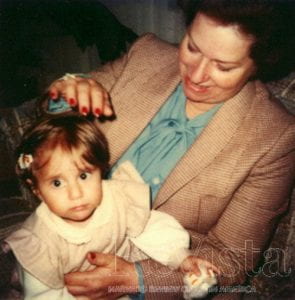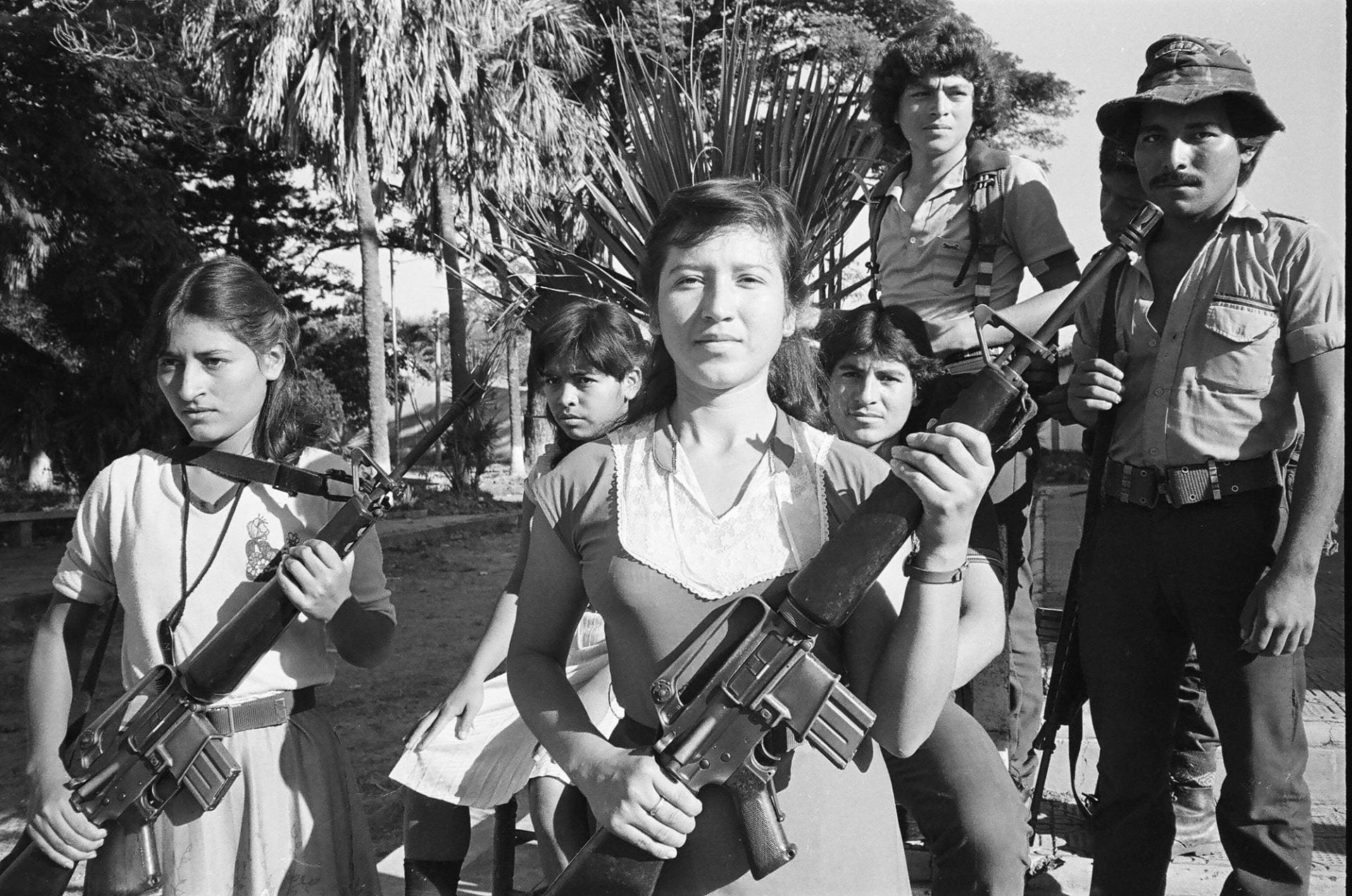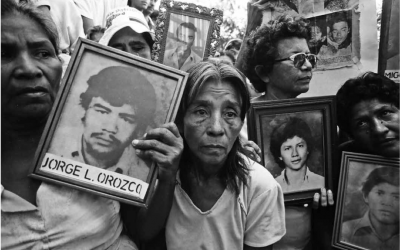Historical Footprints
Changing How We Teach Colombia’s Violent Past

Author Laura Barragán Montaña as a child with her grandmother. Photo courtesy of Laura Barragán Montaña
George Santayana’s well-known dictum, “Those who don’t remember the past are condemned to repeat it,” reminds us why it is important to learn history. But what does this really mean? What aspects of the past must we remember? Who chooses them? How do we remember them? Can this understanding really change our attitudes and behaviors? Are we truly capable of avoiding the mistakes of the past?
In a country like mine, Colombia, these questions are very significant as the country is involved in an intensive peace process. On July 24, 2013, the National Center of Historical Memory officially presented a 434-page long report entitled “¡Basta ya! Colombia: Memorias de guerra y dignidad” (Enough Already: Memories of War and Dignity). No longer can we hide under the excuse that it is too soon or that too little is known. We must embrace this context and really consider how we, as Colombians, are going to face what seems to be an unbearable past. A past that still tarnishes much of our present.
Out of all the possible paths, I have chosen to focus on the role education can play in such a challenge—specifically, on changing how we are teaching and learning about our own history in classrooms across the country.
The back story of oblivion
Like the stories of most Colombians, parts of my own story could bear witness as to how our overwhelming and yet quotidian violence has shaped our lives. But none of it could begin to compare to the extreme suffering experienced by victims who probably do not have the opportunity to write an article for a publication like this one. And yet, the core of my conviction came from an experience both utterly personal and relatable to too many.
Ever since I can remember, my grandmother had been losing her memory. It all started with little details, often inconspicuous. But over the years, these sporadic slip-ups eventually invaded her everyday life. Coming closer to the end of her days and carrying with her the weight of a foreign word like Alzheimer’s, my grandmother helped me understand the havoc wreaked by oblivion. It is not as simple as saying that those who lose their memory only lose their short-term or long-term past. What is more terrifying to see is how this elusive past takes with it the present and future of people with this disease. How it blurs all of time… because when we lose the ability to talk about ourselves in retrospect, it becomes almost impossible to reflect on and recognize oneself in this moment and, even more difficult, to project oneself into the future.
And it was through this new understanding—probably familiar to anyone who has lived with someone who has this disease—that my role as a historian in Colombia finally made sense. Could this small, private, intimate experience be similar to what was, to what is, happening to my country?
We commonly hear that Colombia is suffering from amnesia. But if we are looking for parallels, I believe that Alzheimer’s would be closer. Alzheimer’s is a progressive and fatal disease. It gets worse with the passage of time. It goes beyond oblivion of the past, as my grandmother taught me. It encompasses the loss of an already furtive future. So how can we stop Colombia from suffering from this endemic case of Alzheimer’s. I am proposing that one powerful tool is through a closer examination of how we are teaching history to our students.
History, memory, and the classroom
Although recent years have seen important steps in terms of education reform, most of the social science lessons seem to have remained the same. Many classrooms are still teaching history the way my parents or grandparents learned the subject. Textbooks and curricula (chosen by the schools) tend to reinforce and perpetuate traditional pedagogies: content-driven, instructional, and centered on the actions of few tarnished heroes.
One of my more pressing concerns is that the narrative we are teaching our children is one that hardly fosters any agency—both in pedagogical and historical terms. On the one hand, we are reducing the role of the student to a passive recipient of content-delivery, rather than an inquiring and critical mind who can understand that history is a construction. On the other, we seem to be replicating the belief that we are so deep into our conflict, into decades of corruption, and into mounds of unfulfilled promises, that nothing will ever change.
A teaching of history for this brave new world of the conflict and post-conflict schizophrenia we are living in requires fundamental changes. How can we bring into our classrooms the many narratives that the National Center of Historical Memory has produced? It is not as simple as just printing and shipping copies of the reports or battling for the inclusion of a new chapter in a textbook. We cannot fall prey to the danger of replacing one “truth” with another. The solution lies somewhere else. We must find a way to face what we are teaching, as well as why we are teaching it and how we are teaching.
I believe that it all begins with the teachers. We must understand that no epistemological claim of objectivity can counteract the fact that we are not teaching this history as outsiders. It is the history of our families. The history of our neighbors. The history of our dead. The history of our lives. The story of our present.
However, what we may need as adults, as teachers, is different than what students need. We must process the meaning of this context as victims, bystanders, participants, even perpetrators, before we decide how we can teach this history in our classrooms.
Historical Footprints: Your story is history in the making
It is with this in mind that I and some colleagues have created a nonprofit called Historical Footprints (HF)™. Through one of our main programs, we seek to provide a rigorous teacher training and support system through which social science teachers can ask themselves all these questions, reflect about their practice, and learn new and old methodologies that can counteract the charge that we are teaching an inevitable and irrelevant history.
The principle behind the HF model is that we all have our own Historical Footprint. This term is inspired by the idea of the “carbon footprint” that has done so much to bring environmental concerns into public consciousness. It has done this because it illustrates, in clear and simple terms, how much our habits impact the environment. Thus, “helping” the environment is no longer something that only governments or big corporations can do, but an action that any one of us can accomplish by being mindful of everyday actions. We want to establish a similar notion but in terms of how we impact history.
Therefore, the heart of this proposal is to create new pedagogical methodologies to gauge how everyday life actions determine the course of history. By calculating the Historical Footprints of others in the past, students and teachers can more easily understand how ordinary people have positively and negatively influenced a specific moment in time. It is about learning the past not only through what politicians, heroes, or a few others have done, but by studying how even the worst of atrocities are possible through the multiple actions or inactions many of us have taken.
Our curriculum is a three-step process. Inspired by the already successful model of Facing History and Ourselves, the curriculum begins by analyzing an international case study. Whether it is through examples from the Holocaust, South Africa, Northern Ireland, Peru or Guatemala, this distancing effect is important as a first step. It is not about neglecting our own history. It is about starting with a mirror that can allow us to face many of the issues that we may not be able to articulate if we were to begin with the massacre that happened next door.
After using primary and secondary sources to measure the Historical Footprints of different people in these past international events, the teachers will repeat the process but with a national case study linked to our recent violence. The narratives published by the National Center of Historical Memory will be fundamental to study how ordinary people have caused, suffered and/or endured our violence.
The final step will invite teachers (and through implementation, their students) to gauge their own Historical Footprint. To think about their own history and try to assess the effects their own choices and actions have had. This will not only allow us to have the cathartic effect of storytelling, but will spark a projection into the future.
Yes, Colombia needs bold and significant top-down policies to guide us through this post-conflict path. But we also need bottom-up actions that can, once and for all, prove that changing our history is not something they have to do, but that I, that we, can start to do too. The actions each of us takes vary depending on where and who is reflecting on his or her own Historical Footprint. It may be as small or big as striving to stay in school, creating a more participative classroom, forgiving someone who has wronged us, learning about the reality of rural areas, or actively choosing the hard path of honest work. After all, the metaphor of Historical Footprints is only useful if we harness the ripple effect of our actions to begin to make small changes, small steps that can bring us closer to a peaceful future.
The urgency of now
It is still hard to imagine if we will ever find the right words, images, even silences to properly express the violence we have been through. The violence we are still going through. However, it is equally important to ask ourselves what words we shall use to describe what the future can look like. To envision what we can become. Perhaps Historical Footprints can be part of such a new vocabulary. A vocabulary where we can indeed find new and old paths to combat the Colombian Alzheimer’s by remembering the past and defying our condemnation to repeat it.
Laura Barragán Montaña is the founder and CEO of Historical Footprints in Bogotá, Colombia. During her years in the Colombian Ministry of Education, she worked in the Citizenship Competencies Program and was the creator and project manager of “History Today,” a nationwide program to commemorate Colombia’s Bicentennial of Independence. Barragán recently completed a Master’s in Education at Harvard University, and a summer consultancy for Facing History and Ourselves, in Brookline, MA. She can be reached at laura.barragan@historicalfootprints.org
Related Articles
A Search for Justice
In 2004, when I left Harvard and last saw you, I thought I would never learn the truth of what exactly happened to Carlos Horacio in the horrendous holocaust of the Palace of Justice in Bogotá. Yet fate was holding a tremendous surprise for my daughters and me, filled with…
Memory: Editor’s Letter
Editor's Letter Memory Irma Flaquer’s image as a 22-year-old Guatemalan reporter stares from the pages of a 1960 Time magazine, her eyes blackened by a government mob that didn’t like her feisty stance. She never gave up, fighting with her pen against the long...
A Search for Justice in El Salvador: One Legacy of Ignacio Martín-Baró
In the small rural town of Arcatao, Chalatenango, Rosa Rivera clung to the hope that one day she would find the remains of her disappeared mother and father and lay them to rest in peace. Others sought to exhume mass graves hoping to recover bodies of nearly 1,000 relatives massacred in the Río Sumpul. …




